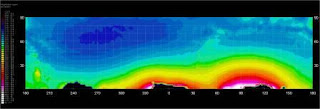National Park Service Organic Act, 16 U.S.C.1.
Protecting and preserving America’s national treasures for current and future generations is the mission of the National Park Service. When considering our nation’s treasures what come to mind first?
Perhaps the wilderness of Yellowstone or the preservation of our nation’s leaders birthplaces or the areas where historic battles were fought. Each National Park is as unique and individual as American citizens themselves. Yet, there is at least one commonality that every park possesses whether you are in California, Nebraska, Alaska, or even Guam. A resource overlooked, even when looking at it.
A disappearing night sky.
The night sky is being threatened with light pollution. The National Park Service Night Sky Program was initiated to investigate the influence of artificial lights upon the nocturnal lightscape. The Night Sky Program (NSP) has developed instrumentation to inventory night sky quality which has been used at over 60 individual parks including Homestead National Monument of America and the results are in.
Teresa Jiles, a Night Sky Technician with the NPS Night Sky Program conducted the study of Homestead’s night sky visibility in August 2008. Ideal weather for accurate readings would be a dry cool night. The Charged-Coupled Device (CCD) camera that generates an image of the entire celestial hemisphere and generates a panoramic map of precise sky brightness values, is best used when placed above obstructions to the horizon.
In the case of Homestead National Monument of America, placing the camera on the roof of the Heritage Center would have been ideal, but was not feasible at the time of the monitoring. In addition to the camera being lower than desired the atmosphere was moisture rich as well.
The results, although telling of the apparent light pollution sources, would need to be compared with results from an ideal monitoring night for a good baseline. Results compiled by the NSP monitoring are below:
Perhaps the wilderness of Yellowstone or the preservation of our nation’s leaders birthplaces or the areas where historic battles were fought. Each National Park is as unique and individual as American citizens themselves. Yet, there is at least one commonality that every park possesses whether you are in California, Nebraska, Alaska, or even Guam. A resource overlooked, even when looking at it.
A disappearing night sky.
The night sky is being threatened with light pollution. The National Park Service Night Sky Program was initiated to investigate the influence of artificial lights upon the nocturnal lightscape. The Night Sky Program (NSP) has developed instrumentation to inventory night sky quality which has been used at over 60 individual parks including Homestead National Monument of America and the results are in.
Teresa Jiles, a Night Sky Technician with the NPS Night Sky Program conducted the study of Homestead’s night sky visibility in August 2008. Ideal weather for accurate readings would be a dry cool night. The Charged-Coupled Device (CCD) camera that generates an image of the entire celestial hemisphere and generates a panoramic map of precise sky brightness values, is best used when placed above obstructions to the horizon.
In the case of Homestead National Monument of America, placing the camera on the roof of the Heritage Center would have been ideal, but was not feasible at the time of the monitoring. In addition to the camera being lower than desired the atmosphere was moisture rich as well.
The results, although telling of the apparent light pollution sources, would need to be compared with results from an ideal monitoring night for a good baseline. Results compiled by the NSP monitoring are below:
The results are showing are source points of light pollution. In the image above the camera is in the center and it took many pictures, spinning around to get a 360 degree light source image. Imagine it like a dome, 360 degrees starting from the horizon then the camera tips up a little and goes around again, it keeps doing so until it is pointing straight up, the whole process took hours. The red indicates where the light pollution is coming from.
The second image is facing toward the north-eastern horizon, the Heritage Center is the middle shadow. The layered color pattern is due to stray scattering in the moisture rising from the prairie and surrounding farms on a hot summer night. The light pollution is stemming from the town of Beatrice (pop. 12,000+) and other area sources. Again the red is indicating sources of light pollution, bear in mind these images were compiled from nightfall till after midnight, which hopefully will get the community thinking about how we can better manage our light sources so it will not have such a negative impact on the night sky.



No comments:
Post a Comment